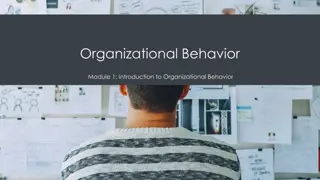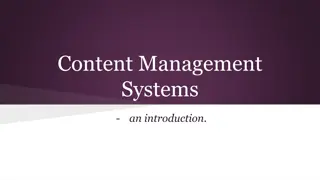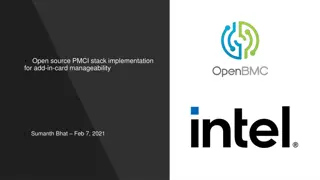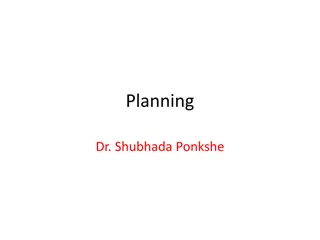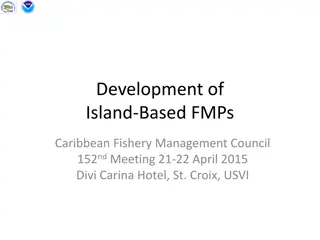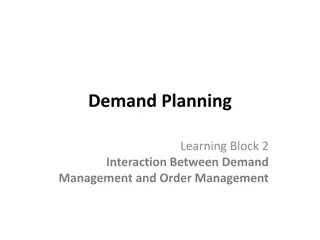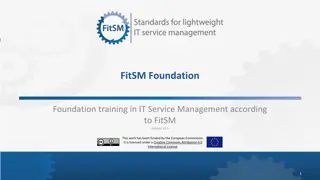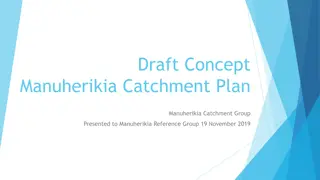
Comprehensive Care and Treatment Plans for Diabetes Management
Providing individualized treatment goals and plans for diabetes, including self-monitoring of blood glucose, HbA1c testing, lifestyle management, and detection/prevention of diabetes-related complications. Treatment goals focus on glycemic control, blood pressure management, and glucose-lowering agents like insulin and other oral medications.
Download Presentation

Please find below an Image/Link to download the presentation.
The content on the website is provided AS IS for your information and personal use only. It may not be sold, licensed, or shared on other websites without obtaining consent from the author. If you encounter any issues during the download, it is possible that the publisher has removed the file from their server.
You are allowed to download the files provided on this website for personal or commercial use, subject to the condition that they are used lawfully. All files are the property of their respective owners.
The content on the website is provided AS IS for your information and personal use only. It may not be sold, licensed, or shared on other websites without obtaining consent from the author.
E N D
Presentation Transcript
Comprehensive medical care in diabetes Individualized treatment goals and plan Self-monitoring of blood glucose (SMBG) HbA1c testing (2 4 times/year) Lifestyle management
Detection, prevention, or management of diabetes- related complications, including: Diabetes-related eye examination Diabetes-related foot examination Diabetes-related neuropathy examination Diabetes-related kidney disease testing Manage or treat diabetes-relevant conditions, including: Blood pressure Lipids Consider antiplatelet therapy Influenza/pneumococcal/hepatitis B immunizations
Treatment goals for adults with diabetes Glycemic control HbA1c <7.0% Preprandial capillary plasma glucose 80 130 mg/dL (4.4 7.2 mmol/L) Postprandial capillary plasma glucosed <180 mg/dL ( <10.0 mmol/L) Blood pressure <140/90 mmHg
Glucose lowering agents.. ORAL Biguanides Alpha glucosidase inhibitors DPP4 inhibitors Insulin secretagogues (sulphonylurea and nonsulphonylurea) SGLT2 inhibitors Thiazolidinediones
PARENTRAL Amylin agoinst GLP1 agonist Insulin
Regimen 1 One shot of long-acting insulin and three shots of short acting insulin to provide glycemic coverage for each meal.
Regimen2 Injection of two shots of long-acting insulin (NPH) and short-acting insulin analogue (glulisine, lispro, insulin aspart [solid red line], or regular insulin [green dashed line]).
Regimen 3 Insulin administration by insulin infusion device is shown with the basal insulin and a bolus injection at each meal.
DIFFERNCES IN THE MANAGEMENT OF TYPE 1 AND TYPE 2 D.M
Biguanides EXAMPLE- Metformin MOA- Hepatic glucose production ADVANTAGES- Weight neutral, do not cause hypoglycemia, inexpensive, extensive experience, CV events DISADVANTAGES-Diarrhea, nausea, lactic acidosis, vitamin B12 deficiency CONTRAINDICATIONS-Renal insufficiency (for GFR <45 mL/min), CHF, radiographic contrast studies, hospitalized patients, acidosis
-Glucosidase inhibitor EXAMPLE-Acarbose, miglitol, voglibose MOA- GI glucose absorption ADVANTAGES-Reduce postprandial glycemia DISADVANTAGES-GI flatulence, liver function tests CONTRAINDICATIONS-Renal/liver disease
Dipeptidyl peptidase IV inhibitor EXAMPLE- Alogliptin, linagliptin, saxagliptin, sitagliptin, vildagliptin MOA- Prolong endogenous GLP-1 action; Insulin, glucagon ADVANTAGES- Well tolerated, do not cause hypoglycemia DISADVANTAGES-Angioedema/ urticarial and immune- mediated dermatologic effects CONTRAINDICATIONS-Reduced dose with renal disease
Insulin secretagogues: Sulfonylurea EXAMPLE- Glibornuride, gliclazide, glimepiride, glipizide, gliquidone, glyburide, glyclopyramide MOA- Insulin secretion ADVANTAGES- Short onset of action, lower postprandial glucose, inexpensive DISADVANTAGES- Hypoglycemia, weight gain CONTRAINDICATIONS- Renal/liver disease
Insulin secretagogues: Nonsulfonylureas EXAMPLE- Mitiglinide nateglinide, repaglinide MOA- Insulin secretion ADVANTAGES-Short onset of action, lower postprandial glucose DISADVANTAGES- Hypoglycemia CONTRAINDICATIONS-Renal/liver disease
Sodium-glucose cotransporter 2 inhibitors EXAMPLE-Canagliflozin, dapagliflozin, empagliflozin, ertugliflozin MOA- renal glucose excretion ADVANTAGES-do not cause hypoglycemia, weight and BP DISADVANTAGES-Urinary and genital infections, polyuria, dehydration, exacerbate tendency to hyperkalemiaand DKA CONTRAINDICATIONS-Moderate renal insufficiency, insulindeficient DM
Thiazolidinedione EXAMPLE-Pioglitazone, rosiglitazone MOA- Insulin resistance, glucose utilization ADVANTAGES- Lower insulin requirements DISADVANTAGES-Peripheral edema, CHF, weight gain, fractures, macular edema CONTRAINDICATIONS-CHF, liver disease
Amylin agonists EXAMPLE- Pramlintide MOA-Slow gastric emptying, glucagon ADVANTAGES- Reduce postprandial glycemia, weight loss DISADVANTAGES-Injection, nausea, risk of hypoglycemiawith insulin CONTRAINDICATIONS-Agents that also slow GI motility
GLP-1 receptor agonists EXAMPLE- Albiglutide, dulaglutide, exenatide, liraglutide, lixisenatide, semaglutide MOA- Insulin, glucagon, slow gastric emptying, satiety ADVANTAGES-Weight loss, do not cause hypoglycemia DISADVANTAGES-Injection, nausea, risk of hypoglycemia with insulin secretagogues CONTRAINDICATIONS-Renal disease, agents that also slow GI motility; medullarycarcinoma of thyroid, pancreatic disease
BILE ACID BINDING RESINS BROMOCRIPTINE
SURGICAL THERAPY pancreas transplantation EMERGING THERAPIES
Lifestyle management (1) diabetes self-management education (DSME) and diabetes self-management support (DSMS) (2) Nutrition therapy (3) Psychosocial care (4) Physical activity
DKA Pathophysiology
DKA management 1. Confirm diagnosis 2. Admit to hospital 3. Assess: Serum electrolytes (K+, Na+, Mg2+, Cl , bicarbonate, phosphate) Acid-base status pH, HCO3 , Pco2 Renal function (creatinine, urine output)
DKA management 4. Replace fluids: 2 3 L of NS over first 1 3 h (10 20 mL/kg per hour) then half NS at 250 500 mL/h change to DNS at 150 250 mL/h when plasma glucose reaches 250 mg/dL (13.9 mmol/L).
DKA management 5. Administer short-acting regular insulin: bolus 0.1 units/kg and 0.1 units/kg per hour by continuous IV infusion increase two- to threefold if no response by 2 4 h. If the initial serum potassium is <3.3 mmol/L (3.3 meq/L), do not administer insulin until the potassium is corrected.
DKA management 6. Assess patient: for the precipitating event and its management 7. Monitering. Measure capillary glucose every 1 2 h electrolytes (especially K+, bicarbonate, phosphate) and anion gap every 4 h for first 24 h. Monitor blood pressure, pulse, respirations, mental status, fluid intake and output every 1 4 h.
DKA management 9. Replace K+: when plasma K+ <5.2 meq/L 10 meq/h (or 20 30 meq/L of infusion fluid) when plasma K+ <3.5 meq/L or if bicarbonate is given. administer 40 80 meq/h serum potassium is >5.2 mmol/L (5.2 meq/L), do not supplement K+ until the potassium is corrected.
DKA management 10. bicarbonate or phosphate supplementation. 11. goals include glucose level between8.3 11.1 mmol/L (150 200 mg/dL), and resolution of acidosis 12. Administer long-acting insulin as soon as patient is eating. Allow for a 2 4 hour overlap in insulin infusion and SC long-acting insulin injection.
HHS Typically.. an elderly individual with type 2 DM, with a several-week history of polyuria, weight loss, and diminished oral intake that culminates in mental confusion, lethargy, or coma. The physical examination reflects profound dehydration and hyperosmolality and reveals hypotension, tachycardia, and altered mental status. Notably absent are symptoms of nausea, vomiting, and abdominal pain and the Kussmaul respirations characteristic of DKA.
Pathophysiology Lab diagnosis Management Fluid replacement Insulin infusion
Diabetes in a hospitalized patient (1)A common management guideline for each hospital (2) Diabetes treatment plans should focus on the transition from the ICU (3) Special focus on discharge treatment regimen
Other considerations in D.M.. TPN GLUCOCORTICOIDS D.M CARE OF OLDER ADULTS REPRODUCTIVE ISSUES LIPODYSROPHIC D.M
The gila monster, the saliva of which is the source of exenatide, a GLP1 agonist
Proinsulin insulin c-peptide
Rich Piana and Ghent Whakefield. Two of the famous body builders who had probably died of insulin abuse.
CGM or continuous glucose monitering device(on right) and closed loop insulin based on CGM (on left)








